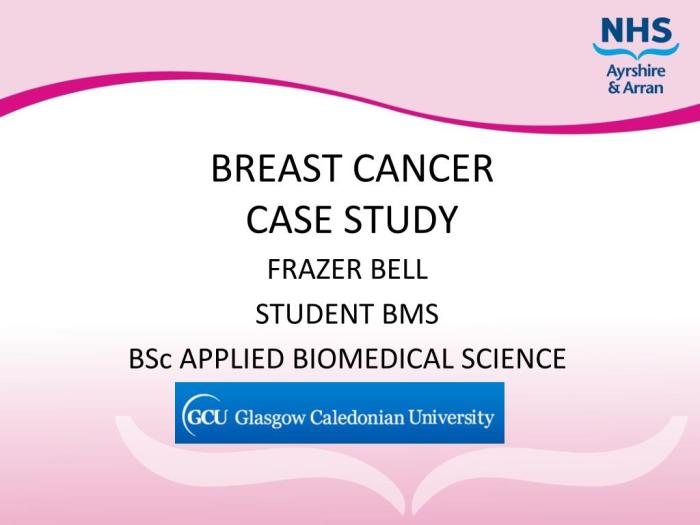Breast cancer hesi case study – Delve into the depths of breast cancer with our HESI case study, an exploration that unveils the intricacies of this prevalent disease. From epidemiology to treatment and beyond, this narrative unfolds with clarity and depth, empowering you with knowledge and insights.
Breast cancer, a formidable adversary, affects countless lives worldwide. Our case study delves into the factors that increase its risk, emphasizing the crucial role of early detection and screening in the fight against this formidable foe.
Breast Cancer Epidemiology

Breast cancer is the most common cancer among women worldwide, accounting for approximately 25% of all female cancer cases. In 2020, there were an estimated 2.3 million new cases of breast cancer diagnosed globally, with over 685,000 deaths.
Risk factors associated with breast cancer include:
- Increasing age
- Family history of breast cancer
- Certain genetic mutations (such as BRCA1 and BRCA2)
- Hormonal factors (such as early menarche, late menopause, and hormone replacement therapy)
- Lifestyle factors (such as obesity, physical inactivity, and alcohol consumption)
Early detection and screening are crucial for improving breast cancer outcomes. Mammograms, breast ultrasounds, and clinical breast exams can help detect breast cancer at an early stage, when it is more likely to be curable.
Pathophysiology of Breast Cancer

Breast cancer is a complex disease characterized by uncontrolled cell growth in the breast tissue. It is the most common cancer among women worldwide.Breast cancer can be classified into different types based on the specific cells involved and the location of the tumor.
The most common types of breast cancer are:
-
-*Ductal carcinoma in situ (DCIS)
Cancer confined to the milk ducts without invading the surrounding breast tissue.
-*Invasive ductal carcinoma (IDC)
Cancer that originates in the milk ducts and has invaded the surrounding breast tissue.
-*Invasive lobular carcinoma (ILC)
Cancer that originates in the milk-producing lobules and has invaded the surrounding breast tissue.
-*Inflammatory breast cancer (IBC)
A rare and aggressive form of breast cancer that causes the breast to become inflamed and red.
The molecular mechanisms underlying breast cancer development are complex and involve multiple genetic and environmental factors. Some of the key molecular events include:
-
-*Mutations in tumor suppressor genes
Tumor suppressor genes, such as BRCA1 and BRCA2, help control cell growth and prevent cancer development. Mutations in these genes can lead to uncontrolled cell growth and cancer formation.
-*Activation of oncogenes
Oncogenes are genes that promote cell growth and division. Mutations or amplifications of oncogenes can lead to excessive cell growth and cancer development.
-*Hormonal factors
Hormones, such as estrogen and progesterone, can promote breast cancer growth. Prolonged exposure to these hormones can increase the risk of developing breast cancer.
Genetics plays a significant role in breast cancer development. Inherited mutations in certain genes, such as BRCA1 and BRCA2, can significantly increase the risk of developing breast cancer. However, most cases of breast cancer are not due to inherited mutations, and the majority of breast cancers are considered sporadic.
Diagnosis and Staging of Breast Cancer

Diagnosing and staging breast cancer are crucial steps in determining the appropriate treatment plan and predicting the prognosis. Various methods are employed for diagnosis, including physical examination, imaging techniques, and biopsies.
Methods of Diagnosis
- Physical Examination:A healthcare professional examines the breasts and underarms to check for lumps, changes in size or shape, or any other abnormalities.
- Mammography:An X-ray technique that creates images of the breast tissue to detect tumors or other changes.
- Ultrasound:A painless procedure that uses sound waves to create images of the breast tissue, providing detailed views of abnormalities.
- Magnetic Resonance Imaging (MRI):A specialized imaging technique that uses magnetic fields and radio waves to produce detailed images of the breast tissue, often used to confirm suspicious findings or screen high-risk individuals.
- Biopsy:A procedure that involves removing a small sample of breast tissue for examination under a microscope to confirm the presence of cancer cells.
TNM Staging System
Once breast cancer is diagnosed, it is staged using the TNM staging system, which takes into account the size and location of the tumor, the involvement of lymph nodes, and the presence of distant metastases.
| Stage | Tumor Size | Lymph Node Involvement | Distant Metastasis |
|---|---|---|---|
| 0 | Non-invasive (confined to the milk ducts or lobules) | No lymph node involvement | No distant metastasis |
| I | Invasive tumor, less than 2 cm | No lymph node involvement | No distant metastasis |
| II | Invasive tumor, 2-5 cm | No lymph node involvement or 1-3 positive lymph nodes | No distant metastasis |
| III | Invasive tumor, greater than 5 cm | More than 3 positive lymph nodes | No distant metastasis |
| IV | Any size tumor | Any number of positive lymph nodes | Distant metastasis |
Importance of Accurate Diagnosis and Staging
Accurate diagnosis and staging of breast cancer are essential for several reasons:
- Treatment Planning:The stage of cancer determines the appropriate treatment options, such as surgery, radiation therapy, chemotherapy, or hormone therapy.
- Prognosis:Staging provides information about the expected outcome and survival rates, allowing for informed decision-making and planning for future care.
- Monitoring and Follow-Up:Accurate staging helps in monitoring the response to treatment and determining the need for additional interventions or follow-up care.
Treatment Options for Breast Cancer: Breast Cancer Hesi Case Study

Breast cancer treatment options have significantly improved over the years, with the goal of preserving the breast, when possible, while effectively treating the cancer.
Surgery
Surgery is the primary treatment for most breast cancers. The type of surgery depends on the stage of the cancer and the patient’s preferences.
- Lumpectomy:Removal of the tumor and a small amount of surrounding tissue.
- Mastectomy:Removal of the entire breast.
- Sentinel lymph node biopsy:Removal of a few lymph nodes near the tumor to check for cancer spread.
- Axillary lymph node dissection:Removal of all lymph nodes in the armpit.
Radiation Therapy
Radiation therapy uses high-energy beams to kill cancer cells. It can be used after surgery to destroy any remaining cancer cells or as a standalone treatment for early-stage breast cancer.
Chemotherapy
Chemotherapy uses drugs to kill cancer cells throughout the body. It can be used before or after surgery, or as a standalone treatment for advanced breast cancer.
Personalized Treatment Plans, Breast cancer hesi case study
The treatment plan for breast cancer is tailored to each patient based on factors such as the stage of the cancer, the patient’s age and overall health, and the type of breast cancer.
Prognosis and Follow-Up Care

Breast cancer prognosis and follow-up care are crucial for a patient’s long-term well-being. Understanding the factors influencing prognosis and the various follow-up options available empowers patients to actively participate in their care.
Factors Affecting Prognosis
Several factors can impact the prognosis of breast cancer, including:
-
-*Stage of cancer
Earlier stages generally have a better prognosis.
-*Tumor size
Smaller tumors tend to be less aggressive and easier to treat.
-*Lymph node involvement
The presence of cancer cells in lymph nodes indicates a higher risk of spread.
-*Hormone receptor status
Tumors that are hormone receptor-positive (ER+ or PR+) tend to have a better prognosis than those that are hormone receptor-negative.
-*HER2 status
HER2-positive tumors are more aggressive and require targeted therapies.
-*Patient’s age and overall health
Younger patients and those with good overall health generally have a better prognosis.
Types of Follow-Up Care
Regular follow-up care is essential for monitoring recovery, detecting recurrence, and providing support. Follow-up options include:
-
-*Clinical exams
Regular checkups with a healthcare provider to assess for any changes or signs of recurrence.
-*Imaging tests
Mammograms, ultrasounds, or MRIs to check for any abnormalities in the breasts.
-*Blood tests
To monitor hormone levels and check for tumor markers.
-*Genetic testing
To assess the risk of developing other cancers.
-*Counseling
Emotional and practical support for patients and their families.
Importance of Survivorship Care
Survivorship care focuses on the long-term needs of breast cancer survivors. It includes:
-
-*Monitoring for recurrence
Regular checkups and tests to detect any signs of cancer returning.
-*Managing side effects of treatment
Addressing any ongoing physical or emotional effects of cancer treatment.
-*Promoting healthy lifestyle
Encouraging a healthy diet, regular exercise, and stress management.
-*Emotional support
Providing counseling and support groups to help survivors cope with the challenges of cancer survivorship.
Nursing Care for Breast Cancer Patients
Nurses play a pivotal role in providing comprehensive care to breast cancer patients, addressing their physical, emotional, and social needs throughout their cancer journey.
Types of Nursing Interventions
Nursing interventions for breast cancer patients encompass a wide range of activities, including:
- Symptom management: Providing relief from pain, nausea, fatigue, and other symptoms associated with cancer and its treatment.
- Patient education: Empowering patients with knowledge about their condition, treatment options, and self-care strategies.
- Emotional support: Offering emotional support, listening to patients’ concerns, and connecting them with support groups.
- Wound care: Managing surgical wounds, dressing changes, and preventing infection.
- Lymphedema management: Educating patients on lymphedema prevention and management techniques.
- Medication administration: Administering medications as prescribed, monitoring for side effects, and educating patients on medication management.
- Advocacy: Advocating for patients’ rights, ensuring they receive appropriate care, and connecting them with community resources.
Importance of Patient Education and Support
Patient education and support are crucial aspects of nursing care for breast cancer patients. Nurses provide information about breast cancer, its treatment options, and potential side effects, empowering patients to make informed decisions about their care.
Nurses also offer emotional support, creating a safe space for patients to express their concerns, fears, and anxieties. They connect patients with support groups, where they can share experiences and learn from others going through similar challenges.
Through patient education and support, nurses help patients navigate their cancer journey with increased confidence, understanding, and a sense of empowerment.
Delving into the complexities of breast cancer through the HESI case study can be an enlightening experience. If you’re preparing for the WSET Level 1 exam, practicing your knowledge through a mock test like the one provided at here can help you gauge your understanding.
Returning to the breast cancer HESI case study, the insights gained can contribute to your comprehensive grasp of the subject matter.
Ethical Considerations in Breast Cancer Care

Breast cancer care presents ethical dilemmas that require careful consideration. These ethical issues encompass patient autonomy, informed consent, and end-of-life care decisions.
Informed Consent and Patient Autonomy
Informed consent is paramount in breast cancer care. Patients have the right to be fully informed about their diagnosis, treatment options, and potential risks and benefits. This information empowers them to make autonomous decisions about their care, ensuring their values and preferences are respected.
End-of-Life Care
End-of-life care for breast cancer patients raises complex ethical challenges. Decisions regarding palliative care, pain management, and hospice services require sensitive and compassionate communication with patients and their families. Respecting patients’ wishes for comfort and dignity while ensuring their physical and emotional well-being is crucial.
Expert Answers
What are the most common risk factors for breast cancer?
Age, family history, genetic mutations, and lifestyle factors such as obesity and alcohol consumption.
How is breast cancer typically diagnosed?
Through mammograms, breast exams, and biopsies.
What are the main treatment options for breast cancer?
Surgery, radiation therapy, chemotherapy, and targeted therapies.